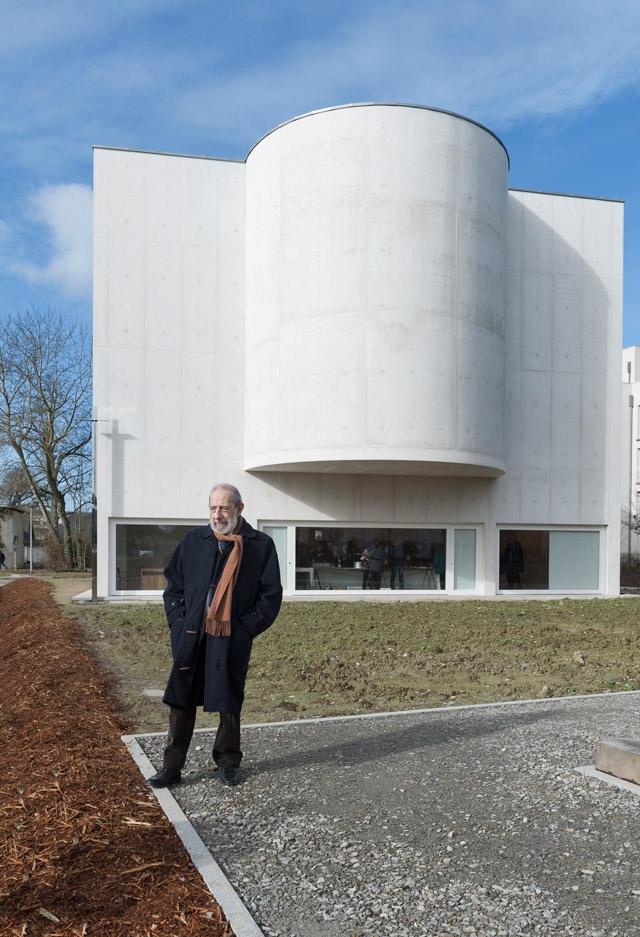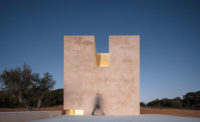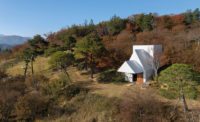Saint-Jacques-de-la-Lande, France—a small town near Rennes in Brittany—began an urban-development initiative more than 25 years ago, one that included 3,200 new housing units and the relocation of the town hall and municipal services. As the population in this area grew, it became apparent that it should have its own place of worship. The resulting Anastasis Church, an intricate puzzle of geometric forms designed by the Portuguese Pritzker Prize–winner Álvaro Siza, opened in February, providing the largely Catholic community with both a spiritual home and a meeting place at the heart of the new town center.
Made of white reinforced concrete, the freestanding 40-foot-high building is straightforward in form: a cylinder on top of an orthogonal volume dotted in each corner by four turret-like blocks. This geometry not only fits comfortably within the surrounding urban fabric, it also exemplifies the work of Siza, 84, whom the Italian architect Vittorio Gregotti called, in his essay for the 1992 Pritzker laureate, “the father of the new architectural minimalism.” Beyond this apparent simplicity, however, lies a complex story.
Additional Content:
Jump to credits & specifications
Paris-based architect Jean-Pierre Pranlas-Descours, who planned the expansion of Saint-Jacques-de-la-Lande, originally proposed that Siza design the church and first discussed it with him in 2009. By the time Siza was set to meet with the archbishop and the Diocesan Commission of Sacred Art, he had studied the site and prepared de- tailed drawings and models. Their instant reaction, recalls Pranlas-Descours, was, “This is our church.”
One of the main concerns in working out the design was the building’s relationship to its present context and how that will play out in the future. “I wanted the church to emerge by completing the environment—as part of it, not as an ‘unusual’ object,” Siza explains. And, indeed, the 7,300-square-foot building distinguishes itself without imposing on the surrounding townscape, instead taking cues from it, namely in its height and color. The tension created by the curves and straight lines, extruding volumes and voids, gives it solidity, and the rugged materiality of the concrete formwork reinforces its human scale. With its detached campanile and surrounding plaza, it establishes a strong sense of place

The brief stipulated that the church be situated on the second floor, with a community center at grade (to include a divisable multipurpose room, an office, kitchen, and restrooms). Siza made the most of this unorthodox request with a design that is surprising in the way it draws on elements of vernacular religious architecture. What appears to be a typical curved apse on the second level, for example, does not correspond to the main altar inside. This is because the building's plan doesn't dictate the orientation of the nave, which is turned 45 degrees in relation to the main entrance.
The sequence of circulation is almost cinematic, beginning with a modest wood-framed glazed entrance. This protected space features a sketch on the glass by Siza depicting the resurrection of Christ, and leads into a welcoming foyer, mostly clad in Portuguese marble, like much of the interior. Climbing the open main stair, the path culminates in the big reveal: a striking view of the 1,500-square-foot sanctuary, bathed in daylight, where curved white plaster walls, marble floors, and wooden furnishings create a serene ambience—with the altar and pulpit directly ahead on a raised wooden platform.
Congregants are guided to move around the periphery of the nave by the placement of the long rows of seating, so that the perception of the space can be taken in all at once. Three small chapels—containing the baptismal font, a statue of the Virgin Mary, and a wooden cross—open off the edges of the circular space. Siza’s scheme, as well as the program and spirit of this Catholic church, all come together here, at its nucleus. The archbishop, says the architect, was unwavering in his support.
Siza’s constant search for perfection has driven his long career but may have been one of his biggest obstacles here in achieving this level of beauty. “The main difficulty was to realize Siza’s design in France, where the culture of detail in construction is not the same as in Portugal, Spain, or Italy,” says Pranlas-Descours. “The challenge was to explain that every part of Siza’s detailed architecture has a relationship with a global concept of the space.”
Perhaps the most intriguing feature in Siza’s work derives precisely from the simplicity that underlies the complexity of each minute detail. “Personally, I think the project is so exceptional,” says Pranlas-Descours, “that it will simply enter the more general history of great French architecture.”
CreditsArchitect: Arquitecto Álvaro Siza Vieira — Álvaro Siza, design principal; Rita Amaral, project coordinator; Avelino Silva, Clemente Menéres, Ana Silva, Cristina Ferreirinha, Maria Souto Moura, project team
Architect of record: Atelier Pranlas-Descours, Architecture & Urbanisme — Jean Pierre Pranlas-Descours, coordinator; Louise de Chatellus, Delphine Bresson, project team
Engineers: EVP (structural); BETHAC (m/e/p)
Consultants: Acoustique Vivié & Associés (acoustics); Atelier Bruel & Delmar (landscape); GPIC, LDA (lighting)
Client: Diocese de Rennes, Dol et Saint-Malo |
Specifications |













Post a comment to this article
Report Abusive Comment